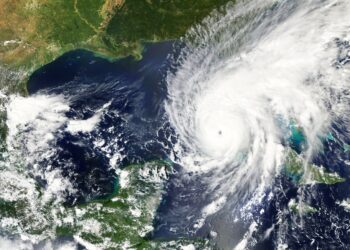We should thank central banks for improving our understanding of climate change data. But they need to more faster and more forcefully to gather more rigorous and comparable data.
Earlier this month, the Federal Reserve Board provided details on how it will conduct its pilot climate scenario analysis focusing on the six largest U.S. banks. These tests will focus on both physical risks from climate change and transition risks that banks are exposed to as the world transitions from fossil fuels. The six banks that will be “taking” the tests are JPMorgan Chase, Citigroup, Goldman Sachs, Bank of America, Morgan Stanley and Wells Fargo.
The first part of the test will concentrate on the risks from a hypothetical hurricane in the Northeast, as all the banks have large real estate loan exposure in this region. The second part of the test will evaluate the risk to bank portfolios if the United States gets on the track to reach net zero by 2050 goals. Such a scenario could adversely impact these banks, as they are currently large financiers to fossil fuel interests.
Participating banks have until July to complete their assessments, with the Fed publishing results by the end of the year.
While this exercise will provide investors some useful data, critics argue that the stress tests don’t go nearly far enough. They have a point.
As currently structured, the stress tests in the U.S. focus mainly on the impact of real estate and corporate loans. They don’t take into account more systemic-level risk, especially in a net zero by 2050 scenario that will affect all sectors of the economy. The assumptions of the Fed also lean heavily on the use of carbon credits. This faith in carbon credits may be unfounded, as the latest exposé by the Guardian is just the latest of not so useful carbon offsets. The carbon offsets often chosen are the cheapest ones, which often means the offsets with the least auditing and oversight.
The results of the tests won’t impact the capital requirements of U.S. banks, but poor scores on the tests could lead to calls for more oversight from the Fed on climate.
Bank of England went first
The Bank of England was the first to publish the results of climate stress tests for banks in May. Some of the findings include:
- Climate risks captured in the Climate Biennial Exploratory Scenario (CBES) scenarios are likely to create a drag on the profitability of U.K. banks and insurers.
- Costs to banks and insurers will be lowest with early well-managed action to reduce greenhouse gas emissions.
- Government policy will be key to determining the speed and shape of a transition.
- Projections from scenarios are uncertain, as that climate scenario analysis is still in its infancy
- There may be a reduction in lending to insurance to sectors that are more exposed to physical risks.
Grades aren’t great in Europe
The latest stress tests conducted by the European Central Bank (ECB) in 2022 found that most banks don’t include climate risk in their credit models. A total of 104 banks participated in these stress tests, with 41 banks that took a more rigorous examination of climate scenario analysis.
The results revealed that around 60 percent of European banks do not yet have a climate risk stress-testing framework. The study found just 20 percent of banks consider climate risk as a variable when granting loans, and about two-thirds of banks’ income from non-financial corporate customers stems from greenhouse gas-intensive industries.
The stress tests showed that credit and market losses from a hypothetical short-term disorderly transition and two physical risk scenarios amounted to around $76 billion on aggregate for the 41 banks subject to the most rigorous test. However, the ECB noted that this result likely understates the actual climate-related risk, as it reflects only a fraction of the actual hazard, owing to: the scarcity of available data at this early stage, the modelling underlying the banks’ projections only capturing climate factors rudimentarily, the exclusion of economic downturns and second-round effects from the scenarios, and the exposures within the scope of this exercise only accounting for around one-third of the total exposures of the 41 banks that were part of the more rigorous test. Clearly, in the future, the scope of these tests needs to be expanded so that the total climate exposure of all European banks can be evaluated.
We aren’t talking apples to apples here
One challenge with these different systems of stress tests is that they aren’t always comparable. What the Fed in the U.S. will be doing is different from the Bank of England, which is different still from the ECB. Other jurisdictions will indeed have different stress tests as more market regulators and financial authorities adopt climate stress tests.
The Network for Greening the Financial System (NGFS) tackled this issue in a recent paper, in which it analyzes the efforts thus far (as of late 2022) and cast a critical eye at the stress test processes. The NGFS notes that these stress tests are mostly an exercise in raising awareness at this point, and that these stress tests will need to improve and become more comparable to be useful.
The NGFS notes that many of these climate scenario exercises do not find severe impacts under an orderly scenario, but report more significant GDP and financial losses for disorderly transition scenarios. They also acknowledge that these exercises are largely exploratory in nature as each central bank is just starting this process. The stress tests are therefore not designed to be comparable to traditional stress tests or assess resilience to tail risks. The NGFS agrees with critics of these tests in noting that climate exposure and vulnerability are likely understated in the stress tests, and that the tests are not capturing secondary impacts. Many exercises also did not consider other potentially large sources of risk, such as those stemming from an abrupt correction in asset prices when transition shocks result in fire sales of assets in exposed sectors.
Finally, the NGFS notes that the data needs to improve for these exercises to be more useful. That is indeed being addressed in many jurisdictions (we are still waiting for a final U.S. Securities and Exchange Commission rule for instance), but will take time.
You have to crawl before you walk then run, but we better start running soon
So, we all need to take a deep breath and be a little patient with this process. But not too patient. The existential threat of climate change needs to hold a bit of a flame under the chair of regulators and central banks that are dipping their toes in the climate disclosure waters.
We should thank central banks for starting this process and improving our understanding of climate change data. But that gentle pat on the back will become a more forceful shove from investors soon if the information doesn’t improve and become more comparable. We don’t have decades to get this right. We likely don’t have years.
No pressure.
Courtesy Greenbiz.com. By Matt Orsagh. Article available here.












